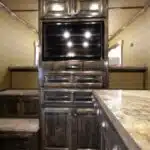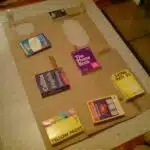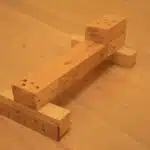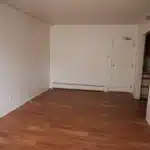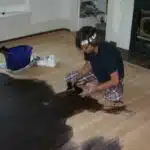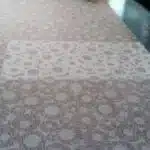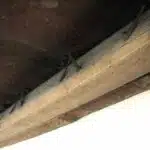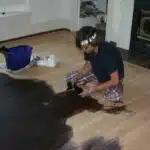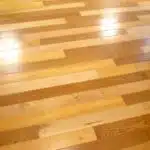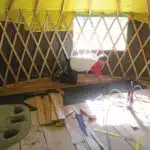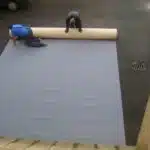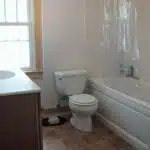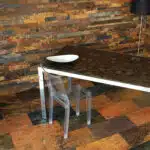Linoleum flooring has been a popular choice for homes and commercial spaces for decades due to its durability, affordability, and easy maintenance. However, there may come a time when you need to remove the linoleum flooring in your space. Whether you are renovating your home or office, or simply want to replace the old flooring with something new and modern, it is important to know how to safely and effectively remove linoleum flooring without causing damage to the underlying subfloor.
As a flooring installation and removal expert, I have seen many cases where homeowners and business owners have attempted to remove linoleum flooring on their own without having the necessary knowledge or tools. This often leads to frustration, wasted time, and even injury. In this article, I will provide you with step-by-step instructions on how to remove linoleum flooring in a safe and efficient manner. By following these guidelines, you can ensure that your space remains structurally sound while creating an updated look that will impress your guests or customers alike.
Assessing The Condition Of The Linoleum Flooring
When considering the removal of linoleum flooring, it is important to first assess its condition. One common issue with linoleum is that it can become brittle and cracked over time, making it more difficult to remove without damaging the subfloor. In such cases, assessing alternatives such as repairing or refinishing the linoleum may be more cost-effective than removing it entirely.
Another factor to consider when assessing the condition of the linoleum is whether there are any signs of water damage or mold growth beneath the surface. If these issues are present, they must be addressed before attempting to remove the linoleum in order to avoid spreading harmful contaminants throughout the space. Assessing cost-effectiveness in this context means weighing the potential costs of repairing or replacing damaged subfloors against those of simply removing and replacing the linoleum.
Finally, it is important to consider any environmental concerns associated with removing old linoleum flooring. Linoleum that was installed prior to 1980 may contain asbestos, a hazardous material that requires special precautions during removal. By carefully assessing the condition of the existing linoleum and understanding all possible options for removal and replacement, homeowners can make informed decisions about their flooring needs while prioritizing safety and cost-effectiveness. Gathering the necessary tools and materials will be essential in successfully removing linoleum flooring without causing damage or risking injury.
Gathering The Necessary Tools And Materials
Assessing the condition of the linoleum flooring is an important step before proceeding with its removal. Once you have determined that the linoleum needs to be removed, it’s time to gather the necessary tools and materials for the job. Choosing the right tools is crucial in ensuring that the task is completed efficiently and effectively.
When removing linoleum flooring, you will need a variety of tools such as a scraper, pry bar, utility knife, and a heat gun. A hammer and chisel may also come in handy for removing any stubborn adhesive residue left behind after removing the flooring. It’s important to choose high-quality tools that can withstand heavy use without breaking or becoming dull.
In addition to selecting the right tools for the job, it’s important to take safety precautions when removing linoleum flooring. Wear protective gear such as gloves, goggles, and a dust mask to protect yourself from any harmful particles or fumes that may be released during the removal process. Make sure to also keep your work area well-ventilated by opening windows or using fans.
Preparing the work area is an essential part of successfully removing linoleum flooring. In order to prevent damage to surrounding surfaces, it’s important to remove all furniture and fixtures from the room prior to starting work. Cover any remaining surfaces with plastic sheeting or drop cloths to protect them from scratches or debris. By taking these steps, you’ll ensure that your work area is safe and ready for effective removal of linoleum flooring.
Preparing The Work Area
Before beginning the removal process, it is important to prepare the work area. This includes measuring the area and setting up proper ventilation. Measuring the area will help determine how much material will need to be removed and how much time will be required for the project. It is crucial to have accurate measurements to avoid any unnecessary waste of resources or time.
Setting up ventilation is also essential before starting any flooring removal project. Linoleum flooring often contains asbestos, which can cause serious health problems if inhaled. Proper ventilation will help reduce exposure to harmful particles during the removal process. Open windows and doors and use fans to create a cross breeze while working.
In addition, it is important to cover any nearby furniture or objects with plastic sheets or drop cloths to protect them from dust and debris. The preparation process may seem tedious, but it is crucial for a safe and successful removal project.
| Emotion | Explanation | Example |
|---|---|---|
| Frustration | Dealing with unexpected obstacles during the project can lead to frustration. | When encountering stubborn adhesive residue on concrete subfloors, a scraper may not be enough for complete removal, leading to frustration for the installer. |
| Satisfaction | Successfully removing old flooring can bring a sense of satisfaction. | Completing a challenging linoleum floor removal project on time and within budget can bring satisfaction and pride in one’s work. |
| Safety | Prioritizing safety during installation/removal projects is vital. | Wearing proper protective gear such as gloves, goggles, respirators when dealing with hazardous materials such as asbestos-containing linoleum protects workers from potential health hazards. |
Preparing the work area is an essential step in any flooring removal project. Accurately measuring the area helps avoid waste of resources while proper ventilation reduces exposure to harmful particles during the job. Additionally, covering nearby furniture or objects with plastic sheets protects them from dust and debris that may be produced during the removal process. As an expert in flooring installation and removal, prioritizing safety is crucial. Understanding and mitigating potential risks, such as asbestos exposure, ensures a safe working environment for everyone involved. Next, it is important to disconnect appliances and electronics before starting the actual removal process.
Disconnecting Appliances And Electronics
Disconnecting appliances and electronics is crucial before removing linoleum flooring. Start by unplugging all electrical appliances and removing any furniture from the room to avoid damage during the removal process. Disconnecting appliances like refrigerators, stoves, and dishwashers will prevent any damage to the appliance or electrical shock. It’s essential to turn off the main power supply before disconnecting any appliance.
Protecting furniture during linoleum removal is a critical step that should not be overlooked. Cover all furniture with plastic sheets to keep them clean and prevent any dust or debris from settling on them. Removing linoleum flooring can create a lot of dust, which can cause respiratory problems if inhaled. Hence, it’s essential to cover all furniture in the room before starting the removal process.
Once all appliances have been disconnected, and furniture has been covered, you can begin removing baseboards and moldings. The baseboard is located at the bottom of the wall where it meets the floor, while moldings are found around doors and windows. Use a pry bar or hammer to remove these carefully without damaging them or the walls. In case of any damage, repair it immediately using putty or wood filler before installing new baseboards and moldings for a seamless finish.
Next Step: Removing Baseboards and Moldings
Removing Baseboards And Moldings
Removing the baseboards and moldings is a necessary step when removing linoleum flooring. These parts of the room are often overlooked but can greatly affect the final appearance of the newly-installed floors. Imagine a beautiful car with rusty, worn-out wheels; it would detract from its overall appeal. In the same way, leaving old baseboards and moldings can detract from the beauty of your new flooring.
Repainting or replacing old baseboards and moldings is an excellent way to give your room a fresh look. After removing them, inspect for any damage or signs of wear and tear. If they are still in good condition, you may choose to repaint them in a new color that matches your new floors. If not, purchasing new ones will give your room an updated look.
When removing baseboards and moldings, take care not to damage the walls or flooring beneath them. Use a putty knife to pry them away from the wall gently. Once removed, label each piece so that you know where they go back when it’s time to reinstall them. This process may seem tedious, but it’s worth it for achieving a polished look in your newly-renovated space.
After repainting or replacing baseboards and moldings, you’re ready to move on to cutting the linoleum into manageable sections for removal. This next step will involve using various tools like utility knives and circular saws and will require careful attention to detail so that you don’t damage any underlying floors or surfaces.
Cutting The Linoleum Into Manageable Sections
Accurately measuring the space and marking the floor with a pencil is an important first step in cutting linoleum into manageable sections. Once marked, the linoleum can be cut into sections using a sharp utility knife, taking care to ensure that the cuts are straight and precise. Once the linoleum is cut into sections, it can be removed by gently pulling each tile or section off the surface. With the correct preparation and cutting technique, removing linoleum flooring can be a straightforward and efficient process.
Measuring And Marking
Achieving accuracy in measuring and marking is crucial when it comes to cutting linoleum into manageable sections. Inaccurate measurements can cause the material to tear or create uneven edges, making the removal process more challenging than it should be. To prevent this from happening, it’s best to use a measuring tape and a straight edge to mark out the dimensions of each section before cutting.
One of the vital techniques that experts use in cutting linoleum is creating a scoring line first. This technique allows for more precise cuts, especially if you’re dealing with large pieces of flooring. To do this, you need a utility knife or a hook blade, then score along your marked line using firm pressure. Once you have scored the material, you can then make your final cut using either a utility knife or a jigsaw.
Another essential technique when cutting linoleum is understanding how to angle your blade correctly to avoid tearing the material. It’s best to hold your blade at an angle of 45 degrees while cutting rather than holding it perpendicular to the surface. Additionally, using a sharp blade will ensure that you achieve clean cuts without any frayed edges or tears on the material.
In conclusion, removing linoleum flooring requires accurate measurement and marking as well as proper cutting techniques. Measuring accurately ensures that each section fits perfectly in place and avoids unnecessary waste of materials while cutting precisely prevents damage to the subflooring beneath. By following these expert tips on measuring and marking, you’ll undoubtedly have an easier time removing linoleum flooring from your space.
Cutting With A Utility Knife
When it comes to cutting linoleum into manageable sections, using a utility knife is a common tool of choice among flooring installation and removal experts. However, safety precautions must be observed when handling this sharp tool. Before starting the cutting process, make sure to wear protective gloves and goggles to avoid injury. It’s also essential to ensure that your workspace is well-lit and free from any obstructions.
While using a utility knife for cutting linoleum may seem like the most straightforward option, there are alternative tools available that can make the job easier. For instance, a jigsaw is ideal for making intricate cuts or working with thicker materials. A circular saw can also be used for longer straight cuts, but it requires more experience and skill than a utility knife. Ultimately, choosing the right tool depends on the specific requirements of your project.
When using a utility knife for cutting linoleum, it’s crucial to use a sharp blade at all times to prevent tearing or fraying of the material. Additionally, holding the blade at an angle of 45 degrees rather than perpendicular to the surface will help you achieve clean cuts without causing any damage to the subflooring beneath. By following these expert tips on using a utility knife and other alternative tools for cutting linoleum, you’ll be able to remove your old flooring efficiently and safely.
Peeling Off The Top Layer Of The Linoleum
After cutting the linoleum into manageable sections, it’s time to remove it from your flooring. There are several methods that can be used to remove linoleum flooring, depending on the stubbornness of the adhesive. Some people prefer to use a heat gun to loosen the adhesive, while others opt for chemical solvents or steam.
Using a heat gun is one of the most effective methods for removing linoleum flooring. Simply turn on your heat gun and hold it close to the linoleum until you see the adhesive start to loosen. Then, use a putty knife or scraper to lift up the edges of the linoleum and gently pull it away from your floor. However, be sure not to hold the heat gun too close or for too long as this can damage your subfloor.
If using a heat gun isn’t an option or you don’t feel comfortable doing so, there are other methods available. Chemical solvents can also be used to dissolve and soften the adhesive, making it easier to remove. Steam is another option that works by penetrating through the layers of linoleum and loosening the adhesive underneath.
Tips for removing stubborn adhesive residue from linoleum flooring include using a scraper or putty knife in combination with solvent or steam treatment. Additionally, wearing gloves and protective eyewear is recommended when working with chemicals or hot surfaces. It’s also important to work slowly and carefully to avoid damaging your subfloor during removal.
Transition: Now that we’ve covered how to loosen adhesive with heat, let’s explore some tips for peeling off top layer of linoleum without causing any damage in our next section.
Loosening The Adhesive With Heat
One effective method for removing linoleum flooring is by using a heat gun to loosen the adhesive. This process involves applying heat directly to the surface of the linoleum, which causes the adhesive to soften and become pliable. The softened adhesive can then be easily scraped away from the subfloor.
Using a heat gun for loosening linoleum adhesive requires some precautions to be taken. First, it is important to wear protective gear such as gloves and eye goggles to avoid burns and eye damage from hot debris. Second, always keep the heat gun moving and at a safe distance from the surface to prevent overheating or scorching of the subfloor.
Another option for removing linoleum is through chemical solvents. These solutions are designed specifically for breaking down adhesive bonds between linoleum and subfloor materials. However, it is important to note that these solvents can be harsh chemicals that emit strong fumes, so proper ventilation must be ensured while using them.
In the next section, we will discuss how to scrape off remaining adhesive and residue after loosening with heat or chemical solvents. It is crucial to remove all traces of adhesive before installing new flooring as any leftover glue can compromise its adherence and durability.
Scraping The Adhesive And Residue
After loosening the adhesive with heat, it’s time to move on to scraping the linoleum flooring and residue. Here are some techniques and tips for removing the leftover adhesive effectively. First, it is essential to choose the right scraper for linoleum flooring. A handheld scraper or a floor scraper with an adjustable handle and replaceable blade is ideal for this job.
Start by positioning the scraper at a 45-degree angle and applying pressure in a forward motion. Be sure to work in small sections, so you don’t damage the subfloor beneath. If there are any stubborn spots, apply heat again and scrape them off gently. Once all of the adhesive and linoleum have been removed, it’s time to clean up any remaining residue. Use a solution of warm water and vinegar or purchase a commercial adhesive remover that is safe for your subfloor type.
Removing linoleum residue can be challenging, but with these techniques, you can make a previously daunting task much more manageable. Remember to choose the right scraper for your linoleum flooring type and work in small sections while applying pressure in a forward motion. In the next section, we’ll discuss sanding the subfloor to ensure that it’s smooth and ready for new flooring installation.
Sanding The Subfloor
After removing the linoleum flooring, it is crucial to prepare the subfloor properly for a new installation. Subfloor preparation involves getting rid of any remaining adhesive or debris that may have been left behind. Sanding the subfloor is an effective way of achieving this.
Sanding techniques vary depending on the condition of the subfloor and the type of adhesive used. For example, if the adhesive is soft, you may need to use a coarser sandpaper to remove it effectively. On the other hand, if it is hard and stubborn, using a finer grit sandpaper will work best. It is important to note that excessive sanding can damage the subfloor and make it uneven.
To achieve a smooth surface ideal for installing new flooring, follow these tips:
- Begin by inspecting the surface thoroughly and determining whether there are any nails or screws sticking out.
- Use an industrial sander fitted with coarse-grit sandpaper to remove any remaining adhesive or debris quickly.
- Finish off with a fine-grit sandpaper to smoothen out any rough areas.
In conclusion, preparing your subfloor properly after removing linoleum flooring is critical in ensuring your new floor installation is successful. Sanding techniques play an essential role in achieving a smooth and even surface suitable for laying down new flooring materials without defects. Moving forward into inspecting your subfloor for damage, you must take caution not to cause any harm while performing this critical step.
Inspecting The Subfloor For Damage
After sanding the subfloor, it’s important to inspect it for any damages that may have been caused by the removal of the linoleum flooring. This is a crucial step in ensuring that your new flooring will be installed properly and last for years to come. One common damage to look out for is unevenness or warping of the subfloor. This can occur due to moisture exposure or previous improper installation techniques.
Another potential issue is rotting or decay of the subfloor, which can occur if there was water damage that went unnoticed over time. In this case, it’s essential to repair any damaged areas before proceeding with the installation of new flooring. Safety precautions should also be taken during this inspection process, as you’ll need to get on your hands and knees to fully examine all areas of the subfloor. Wear protective gloves and knee pads, as well as safety glasses if necessary.
If you do notice any damages during your inspection, take note of their location and severity so that you can address them later on. Repairing any damage to the subfloor is an important step in ensuring a successful installation of new flooring. It’s recommended that you consult with a professional if you’re unsure about how to go about repairing certain types of damage or if you suspect that there may be more extensive issues at play. By taking these necessary precautions, you’ll ensure that your new flooring will be installed correctly and provide a safe and stable surface for years to come.
Repairing Any Damage To The Subfloor
Carefully inspect the subfloor for any signs of damage such as holes, gouges, and cracks before attempting to remove the linoleum flooring.
If any holes or gouges are found, patch them up with wood putty or wood filler before proceeding with the removal process.
Cracks should be sealed up with a clear sealant prior to removing the linoleum flooring.
After the subfloor has been inspected and any necessary repairs have been made, the linoleum flooring can be removed safely.
Begin by cutting the linoleum in strips with a utility knife before attempting to remove it.
Once the linoleum is cut in strips, use a pry bar to carefully and slowly lift it up in sections.
Inspecting The Subfloor
Before removing linoleum flooring, it is important to inspect the subfloor thoroughly for any damage. Assessing moisture is a crucial aspect of this inspection process. This is because moisture can cause the subfloor to rot, which can lead to further problems in the future. In order to assess the moisture level of the subfloor, you can use a moisture meter or simply observe any signs of dampness or discoloration. If there are any signs of excess moisture, it is important to address this issue before proceeding with the removal process.
Another important consideration when inspecting the subfloor is whether or not there is asbestos present. Asbestos was commonly used in flooring materials prior to the 1980s and can pose serious health risks if not handled properly. If your linoleum flooring was installed prior to this time period, it is important to have it tested for asbestos before attempting to remove it. If asbestos is present, you will need to hire a professional removal service that has experience dealing with this hazardous material.
If there are no issues with moisture or asbestos, you can move on to inspecting for any other damage such as cracks or holes in the subfloor. These should be repaired before installing new flooring so that your new surface sits evenly and securely on a sturdy foundation. In some cases, you may need to replace sections of the subfloor entirely if they are too severely damaged. By taking these steps in inspecting and repairing your subfloor, you can ensure that your new flooring will last longer and look better overall without encountering any unforeseen problems.
In conclusion, assessing moisture levels and dealing with asbestos are two crucial considerations when inspecting your subfloor before removing linoleum flooring. Additionally, checking for cracks or other damage will help ensure that your new flooring sits evenly and securely on a sturdy foundation. By taking these steps, you can avoid costly repairs down the line and enjoy beautiful new floors that stand the test of time.
Patching Holes Or Gouges
After inspecting the subfloor for moisture and asbestos, it is important to check for any other damage such as cracks or holes. These imperfections can cause your new flooring to sit unevenly and may even lead to further damage if left unaddressed. Fortunately, patching holes or gouges is a relatively simple process that can be done by anyone with basic DIY skills.
To begin, use a putty knife to remove any loose debris from the damaged area. Then, fill the gap with a suitable filler material such as wood putty or leveling compound. Make sure to follow the manufacturer’s instructions carefully and apply multiple layers if needed until the surface is smooth and level. Once the filler has dried completely, sand it down using a fine-grit sandpaper until it is flush with the surrounding subfloor.
By patching holes or gouges in your subfloor before installing new flooring, you can ensure that your new surface sits evenly and securely on a sturdy foundation. This will not only improve the appearance of your floors but also help extend their lifespan by preventing future damage from occurring. So take some time to inspect your subfloor for imperfections and make any necessary repairs before moving forward with your flooring installation project.
Sealing Subfloor Cracks
After patching any holes or gouges found in the subfloor, it is crucial to also check for any cracks. Cracks can cause instability and unevenness in the new flooring, leading to further damage if not addressed properly. Using filler or leveling compound for subfloor cracks is an effective solution to ensuring a smooth and level surface.
To begin sealing subfloor cracks, clean the area thoroughly with a vacuum or broom. Then, apply a moisture barrier to protect against any future water damage. Once the barrier has dried, use a suitable filler or leveling compound to fill in the crack. Follow the manufacturer’s instructions carefully and apply multiple layers if necessary until the surface is smooth and level.
Sealing subfloor cracks will not only improve the appearance of your floors but also protect them from future damage caused by moisture or other factors. By taking these proactive steps, you can ensure that your new flooring sits securely on a sturdy foundation for years to come. Incorporating these practices into your flooring installation project will lead to greater customer satisfaction and peace of mind knowing that their floors are built on a strong base.
Cleaning Up The Work Area
After successfully removing the linoleum flooring, it is important to take some time to clean up the work area. This will not only help make the space look tidier and more organized but also prevent any accidents or injuries that may result from tripping over tools or debris. Tips for organization include sorting tools and materials into separate piles, disposing of old flooring materials properly, and sweeping or vacuuming the work area thoroughly.
Safety precautions should also be taken when cleaning up after removing linoleum flooring. Wear gloves and a respirator mask to protect yourself from any debris or dust that may still be lingering in the air. Additionally, ensure that all sharp objects such as blades or nails are disposed of properly, preferably in a designated bin or container. If you have children or pets, keep them away from the work area until it has been completely cleaned up.
Lastly, take some time to reflect on what went well during the removal process and what could have been done better. This will help you learn from your experience and improve your skills for future projects. Additionally, consider how you want to proceed with installing new flooring. Will you do it yourself or hire a professional? What type of flooring do you want? These are important questions to answer before moving forward with your next steps towards creating a beautiful new floor for your home.
Installing New Flooring
After cleaning up the work area, it’s time to remove the linoleum flooring. This process can be done either through DIY or professional installation. DIY can save you money, but it requires a lot of time and effort. On the other hand, hiring a professional ensures that the job is done quickly and efficiently.
Before starting the removal process, make sure to choose the right flooring material for your space. There are several options available in the market such as vinyl, hardwood, laminate, and carpet tiles. Consider factors such as durability, maintenance requirements, and cost before making your final decision.
When removing linoleum flooring, it’s important to take proper safety precautions. Wear gloves and protective eyewear to prevent injuries from sharp tools or chemicals used during the process. Use a scraper or putty knife to lift up the edges of the linoleum and pull it off slowly while ensuring that you don’t damage the subfloor underneath.
If you’re unsure about removing linoleum flooring yourself or want to ensure a flawless installation of new flooring material, consider hiring a professional for assistance. They have years of experience and knowledge in this field which they can use to guarantee high-quality results. In addition, professionals have access to specialized equipment that makes their work more efficient than DIY methods.
Hiring A Professional For Assistance
Anachronism: Back in the day, removing linoleum flooring was a tedious and time-consuming task that required immense effort. However, times have changed, and professionals now have access to advanced tools and techniques that make this process much easier.
Hiring a professional for assistance can provide numerous benefits when it comes to removing linoleum flooring. Firstly, professionals are equipped with the appropriate tools and equipment needed to remove the flooring safely and efficiently. They have experience working with different types of linoleum floors, which means they can handle any challenges that may arise during the removal process.
While some people may think that hiring a professional is an unnecessary expense, it can actually be cost-effective in the long run. Attempting to remove linoleum flooring on your own can lead to costly mistakes or damage to your subfloor. By hiring a professional, you can ensure that the job is done right the first time around, saving you money on potential repairs down the line.
In summary, hiring a professional for assistance with removing linoleum flooring can provide numerous benefits including access to advanced tools and equipment, experience in handling different types of floors, and cost-effectiveness in preventing potential damage or mistakes. Trusting an expert will ensure that your project is completed seamlessly without any issues or worries.
Conclusion
Assessing the condition of linoleum flooring is crucial before initiating its removal. After assessing, gather the necessary tools and materials to make the process smoother. Preparing the work area will ensure a safe and efficient removal process. Disconnecting appliances and electronics will prevent any damage during the removal process.
Removing baseboards and moldings is essential as they can cause obstructions during removal. Repairing any damage to the subfloor is necessary to prevent further issues down the line. Cleaning up the work area after removing linoleum flooring will ensure that you have a clean slate for your new flooring installation.
As a flooring installation and removal expert, I recommend hiring a professional for assistance in removing linoleum flooring if you are unsure of how to do it yourself. With their expertise, they can guarantee a smooth and safe removal process without causing any damage to your home or injuring yourself. Remember, always prioritize safety when removing linoleum flooring and take your time in ensuring that everything is done correctly. With these steps, you will be on your way to installing beautiful new floors in no time!
Image Credits
- “C. H. Pepper’s Linoleum floor-cloth, linoleum for nurseries (front)” by Boston Public Library (featured)


